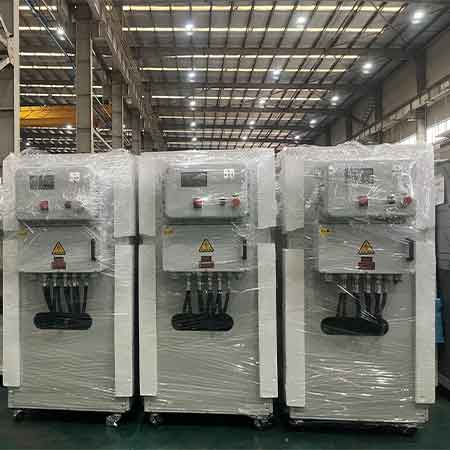Injection Mold Temperature Controller
All kinds of plastics are ubiquitous in life, how is this manufactured? How did it come into various shapes? Plastic molding generally has injection molding, extrusion molding, blow molding, thermoforming and other molding methods. Which method to choose depends on product design and demand, but the role of mold temperature controller in molding is indispensable.
Let’s start with an overview of how plastics are made. The manufacture of plastics mainly involves two processes: synthesis and molding. First let’s look at the synthesis of plastics:
1. Extraction of raw materials: The main raw materials of plastics are petroleum, natural gas and coal. These fossil fuels are refined and cracked to form various base chemicals such as ethylene, propylene, etc.
2. Polymerization: The basic chemical substances are polymerized to form macromolecular polymers, that is, plastics. There are many ways of polymerization reaction, including polymerization, polycondensation, polyaddition and so on. Different polymerization methods and raw materials can produce different kinds of plastics, such as polyethylene, polypropylene, polyester, polycarbonate, etc.

Then there is the molding process of the plastic. The plastic manufacturing molding process usually includes the following steps:
1. Pretreatment: The raw plastic material (usually granules or powder) is first cleaned and dried. In some cases, the plastic material may also require preheating.
2. Melting and mixing: The pretreated plastic material is heated to a fluid state in a melting device such as an extruder or the screw of an injection molding machine. It is also possible to add other additives during this process, such as colorants, reinforcing agents or flame retardants, etc., and then mix.
3. Molding: Molten plastic is fed into the mold for molding. There are many methods of molding, including injection molding, extrusion molding, blow molding, thermoforming and so on. Which method to choose depends on the design and requirements of the final product.
4. Injection molding: This is a common plastic molding method, usually used to produce a large number of fixed-shaped plastic parts. The molten plastic is injected into the closed mold cavity under high pressure, and after cooling and solidification, the mold is opened to take out the product.
5. Extrusion molding: This method is usually used to produce plastic tubes, films or long strip products. Molten plastic is extruded through a fixed nozzle (die) and cooled to solidify.
6. Blow molding: This method is used to produce hollow plastic products such as bottles. The molten plastic is extruded into a thermoplastic tube, which is then blown inside the mold to expand it to the shape of the mold, and the product is removed after cooling.
7. Thermoforming: In this process, the plastic sheet or film is first heated to melt or soften, and then the shape changes according to the mold under the action of vacuum or pressure, and it is taken out after cooling and solidification.
8. Cooling: After molding, the plastic needs to be cooled. Cooling can be by air, water or other cooling media. The cooling process needs to be well controlled to prevent product warping or dimensional changes.
9. Post-processing: After cooling and demoulding, further post-processing may be required, such as cutting, grinding, painting or assembly, etc.
The above is the general process of plastic manufacturing and molding, and the specific process may vary slightly depending on the type of plastic, product design and production requirements.
Whether it is injection molding, extrusion molding, blow molding, thermoforming or other molding processes, temperature control is required, and the key to temperature control is the mold temperature controller.

The mold temperature controller is mainly used to precisely control the temperature of the mold to achieve the purpose of improving product quality and production efficiency. The temperature of the mold has an important influence on many plastic molding and rubber molding processes, and different plastic and rubber materials need to be molded at different temperatures.
The main functions of the mold temperature controller include:
1. Keep the temperature of the mold stable: During the molding process, plastic or rubber is filled, cooled and solidified inside the mold, and heat is generated during the process. Without effective temperature control, the mold temperature will rise, resulting in unstable dimensions and properties of the molded product. The mold temperature controller can keep the mold temperature stable by circulating heating or cooling media.
2. Improve product quality: Accurate control of mold temperature can avoid product defects caused by excessive or low temperature. For example, if the mold temperature is too high, the plastic may burn or deform; if the mold temperature is too low, the plastic may start to cool and solidify before the mold is completely filled, resulting in quality problems such as voids or shrinkage marks inside the product.
3. Improve production efficiency: The mold temperature controller can also shorten the cooling time of the product and improve production efficiency. Proper mold temperature can ensure that the plastic cools and solidifies in the shortest time, thereby speeding up the production pace.
4. Energy saving: By controlling the mold temperature accurately, unnecessary energy waste can be avoided. For example, if the mold temperature is too high, additional cooling equipment may be required to reduce the temperature; if the mold temperature is too low, additional heating equipment may be required to increase the temperature. A mold temperature controller can keep the mold temperature within the ideal range, avoiding this waste of energy.
Therefore, the mold temperature controller plays a very important role in the plastic and rubber molding industry.
 LNEYA
LNEYA
 简体中文
简体中文

















































































